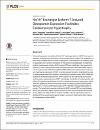Computational structural assessment of BReast CAncer type 1 susceptibility protein (BRCA1) and BRCA1-Associated Ring Domain protein 1 (BARD1) mutations on the protein-protein interface
عرض / فتح
التاريخ
2022المؤلف
Thirumal Kumar, D.Udhaya Kumar, S.
Jain, Nikita
Sowmya, Baviri
Balsekar, Kamakshi
Siva, R.
Kamaraj, Balu
Sidenna, Mariem
George Priya Doss, C.
Zayed, Hatem
...show more authors ...show less authors
البيانات الوصفية
عرض كامل للتسجيلةالملخص
Breast cancer type 1 susceptibility protein (BRCA1) is closely related to the BRCA2 (breast cancer type 2 susceptibility protein) and BARD1 (BRCA1-associated RING domain-1) proteins. The homodimers were formed through their RING fingers; however they form more compact heterodimers preferentially, influencing BRCA1 residues 1-109 and BARD1 residues 26-119. We implemented an integrative computational pipeline to screen all the mutations in BRCA1 and identify the most significant mutations influencing the Protein-Protein Interactions (PPI) in the BRCA1-BARD1 protein complex. The amino acids involved in the PPI regions were identified from the PDBsum database with the PDB ID: 1JM7. We screened 2118 missense mutations in BRCA1 and none in BARD1 for pathogenicity and stability and analyzed the amino acid sequences for conserved residues. We identified the most significant mutations from these screenings as V11G, M18K, L22S, and T97R positioned in the PPI regions of the BRCA1-BARD1 protein complex. We further performed protein-protein docking using the ZDOCK server. The native protein-protein complex showed the highest binding score of 2118.613, and the V11G mutant protein complex showed the least binding score of 1992.949. The other three mutation protein complexes had binding scores between the native and V11G protein complexes. Finally, a molecular dynamics simulation study using GROMACS was performed to comprehend changes in the BRCA1-BARD1 complex's binding pattern due to the mutation. From the analysis, we observed the highest deviation with lowest compactness and a decrease in the intramolecular h-bonds in the BRCA1-BARD1 protein complex with the V11G mutation compared to the native complex or the complexes with other mutations. 2022 Elsevier Inc.
المجموعات
- العلوم الحيوية الطبية [763 items ]
وثائق ذات صلة
عرض الوثائق المتصلة بواسطة: العنوان، المؤلف، المنشئ والموضوع.
-
The Role of Epidermal Growth Factor Receptor Family of Receptor Tyrosine Kinases in Mediating Diabetes-Induced Cardiovascular Complications
Shraim B.A.; Moursi M.O.; Benter I.F.; Habib A.M.; Akhtar S. ( Frontiers Media S.A. , 2021 , Article)Diabetes mellitus is a major debilitating disease whose global incidence is progressively increasing with currently over 463 million adult sufferers and this figure will likely reach over 700 million by the year 2045. It ... -
Universal Genetic Testing for Newly Diagnosed Invasive Breast Cancer
Rezoug, Zoulikha; Totten, Stephanie P.; Szlachtycz, David; Atayan, Adrienne; Mohler, Kristen; Albert, Sophie; Feng, Leila; Lemieux Anglin, Brianna; Shen, Zhen; Jimenez, Daniel; Hamel, Nancy; Meti, Nicholas; Esfahani, Khashayar; Boileau, Jean-François; Prakash, Ipshita; Basik, Mark; Meterissian, Sarkis; Tremblay, Francine; Fleiszer, David; Anderson, Dawn; Chong, George; Wong, Stephanie M.; Foulkes, William D.... more authors ... less authors ( American Medical Association , 2024 , Article)IMPORTANCE Between 5% and 10% of breast cancer cases are associated with an inherited germline pathogenic or likely pathogenic variant (GPV) in a breast cancer susceptibility gene (BCSG), which could alter local and systemic ... -
Na+/H+ exchanger isoform 1-induced osteopontin expression facilitates cardiomyocyte hypertrophy
Mohamed, Iman A.; Gadeau, Alain-Pierre; Fliegel, Larry; Lopaschuk, Gary; Mlih, Mohamed; Abdulrahman, Nabeel; Fillmore, Natasha; Mraiche, Fatima... more authors ... less authors ( Public Library of Science , 2015 , Article)Enhanced expression and activity of the Na+/H+ exchanger isoform 1 (NHE1) has been implicated in cardiomyocyte hypertrophy in various experimental models. The upregulation of NHE1 was correlated with an increase in osteopontin ...




